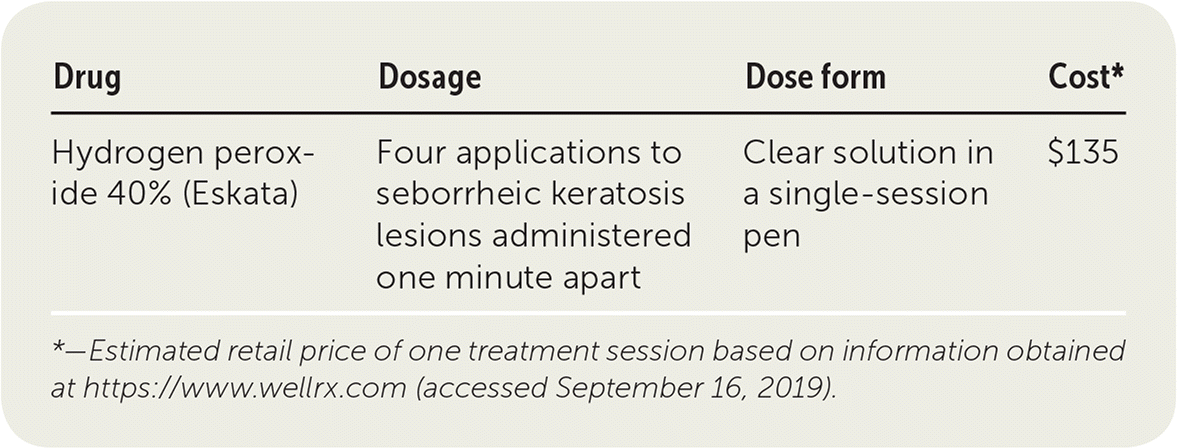
Am Fam Physician. 2019;100(10):643-644
Author disclosure: No relevant financial affiliations.
Hydrogen peroxide 40% (Eskata) is a topical solution for the in-office treatment of raised seborrheic keratosis lesions.1 Although the mechanism of action is not fully understood, supraphysiologic concentrations of hydrogen peroxide may cause oxidative damage and death to seborrheic keratosis cells.2
Safety
Hydrogen peroxide 40% may cause corneal injury, chemical conjunctivitis, eyelid edema, severe eye pain, or permanent eye injury, including blindness, if the eye or mucous membranes are exposed to the topical solution during application. Severe skin reactions including erosion, ulceration, and vesiculation have been reported in approximately 1% of patients.1
Tolerability
Skin reactions are common with the application of hydrogen peroxide 40%. Most patients will experience erythema (99%), stinging (97%), edema (91%), scaling (90%), crusting (81%), and pruritus (58%) within 10 minutes of application, although less than 20% of cases will be severe. One week after treatment, scaling (72%), crusting (67%), and erythema (66%) often persist. Long-term skin changes are common and include erythema (21%), hyperpigmentation (18%), scaling (16%), crusting (12%), and hypopigmentation (7%). A small number of patients will develop scarring (3%).1

| Drug | Dosage | Dose form | Cost* |
|---|---|---|---|
| Hydrogen peroxide 40% (Eskata) | Four applications to seborrheic keratosis lesions administered one minute apart | Clear solution in a single-session pen | $135 |
Effectiveness
The effectiveness of hydrogen peroxide 40% has been investigated in two randomized studies of 937 patients (98% were white) who were 42 to 91 years of age.1 The primary end point assessed clearing of four raised lesions on the face, trunk, or extremities three and a half months after application of either hydrogen peroxide 40% or vehicle only, at days 1 and 22. Most patients required a second treatment at day 22. When data from the two trials were combined, 6% of patients achieved clearing of all four lesions (number needed to treat = 17), and 18% of patients achieved clearing of three lesions (number needed to treat = 6).1 No lesions cleared with the vehicle-only application.
Price
Hydrogen peroxide 40% solution costs approximately $135 per treatment session, with more than one treatment session typically needed. This does not include the cost of administration by a medical professional. Hydrogen peroxide 40% is not covered by insurance.
Simplicity
Hydrogen peroxide 40% topical solution is available in a single-session pen applicator to be administered by a medical professional. The solution is applied to the lesion in a circular motion enough to uniformly wet the lesion surface without excess running or dripping. Any extra solution should be removed with an absorbent wipe. After a period of one minute to assess for pain and erythema severity, hydrogen peroxide 40% is reapplied three additional times, if tolerated. The site should be dry before the patient leaves the office and topical products should not be applied for at least six hours. If the lesion is not completely cleared at three weeks and the skin has healed from any local reactions, the solution may be reapplied.1
Bottom Line
Hydrogen peroxide 40% topical solution is not particularly effective for removing seborrheic keratosis lesions, and skin reactions are common. Long-term minor cosmetic changes may occur, including hyperpigmentation and hypopigmentation. Hydrogen peroxide 40% topical solution is expensive and requires out-of-pocket payment by patients. Given the high cost of the solution and its potential for adverse effects, other options will be preferred by most patients.
